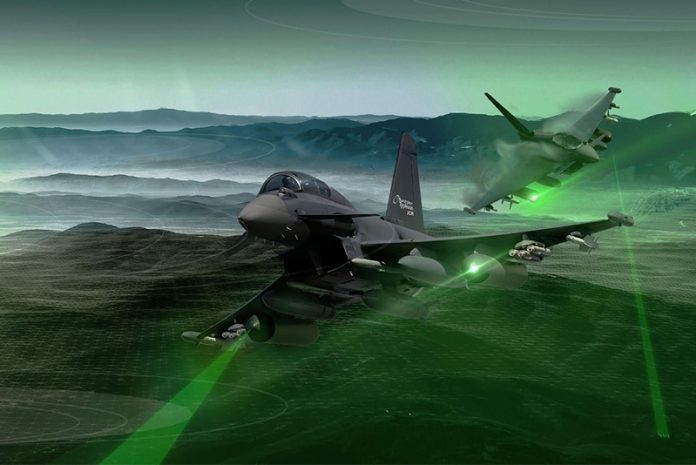
The European Union has launched a project to develop an airborne electronic attack pod to equip combat aircraft as part of its PESCO initiative.
Permanent Structured Cooperation (PESCO) forms a cornerstone of the European Union’s Common Defence and Security Policy (CSDP). PESCO projects serve to deepen cooperation and resource-sharing on military equipment research and development; acquisition and employment. The latter concerns those programmes under the auspices of the European Defence Agency (EDA), the European Union’s (EU) organisation tasked with improving Europe’s defence capabilities.
The Airborne Electronic Attack (AEA) pod was launched in April 2019 with the intention of developing a “pod to be used by EU air platforms in contested electromagnetic environments,” according to the original funding and tender opportunity published by the European Commission, the EU’s executive branch.
The document continued that the AEA “must find, locate and track electromagnetic threats and deliver high power jamming signals in the full radio frequency spectrum used in military operations.”
The publication added that the proliferation of sophisticated ground-based air defences such as Surface-to-Air Missile (SAM) systems with engagement ranges in excess of 216 nautical miles/nm (400 kilometres/km) posed dangers by creating areas where “air power cannot operate or be projected,” with the risk that such weapons could deny “access to large swathes of territory over an EU nation’s airspace.”
This appears to be a thinly-veiled reference to Russia’s Almaz-Antey S-400 Triumf (NATO reporting name SA-21 Growler) SAM system. One month before the solicitation was published, it was reported that Russia had deployed an S-400 battery to protect its Kaliningrad enclave in the Baltic region.
The AEA will use electronic attack to protect formations of aircraft against such threats by jamming the latter’s radars. It appears that the initiative is also aimed at easing the dependence of EU nations on the US air defence suppression assets the US Air Force has deployed in Europe, should EU members be involved in future multilateral operations sans the United States.
These capabilities include around 24 General Dynamics/Lockheed Martin F-16CJ Viper Weasel air defence suppression aircraft deployed with the 480th Fighter Squadron, part of the 52nd Fighter Wing, at Spangdahlem airbase, western Germany. These aircraft are equipped with Raytheon’s AN/ASQ-213(V) HTS (HARM Targeting System) to detect and geo-locate hostile emitters, and the Raytheon AGM-88B/C High Speed Anti-Radiation Missile (HARM) family of air-to-surface weapons to prosecute such targets.
CONOPs and Performance
Once in service, the AEA pod could complement the kinetic SEAD (Suppression of Enemy Air Defence) capabilities in service with the Luftwaffe (German Air Force), and the Aeronautica Militaire (Italian Air Force). These include 21 Panavia Tornado-ECR jets flown by the Luftwaffe and five similar aircraft flown by the Aeronautica Militaire.
These aircraft can also deploy the AGM-88B/C, and are transitioning to the more advanced Northrop Grumman AGM-88E Advanced Anti-Radiation Guided Missile. In place of the AN/ASQ-213(V) the Tornado-ECR uses Raytheon’s Emitter Locator System which is similar in performance to the HTS.
Over the long term, the Luftwaffe is considering a replacement for the Tornado-ECR with the jet expected to be retired by circa 2030.
In November Airbus offered a variant of its Eurofighter Typhoon combat aircraft series configured to support the SEAD mission. Reports stated that this variant of the aircraft could be equipped with an escort jammer, for which the AEA could be a prime candidate, along with MBDA’s Spear-EW stand-in jammer. This would allow the aircraft to provide an electronic attack escort for strike packages of aircraft ingressing and egressing towards their targets, and a fire-and-forget jammer which could provide additional electronic protection to aircraft loitering in contested airspace.
Sources close to the initiative have also told Armada Analysis that a variant of MBDA’s Meteor radar-guided beyond-line-of-sight air-to-air missile, configured with a radio frequency seeker to detect and home in on hostile radar transmissions could equip the aircraft. This would be dependent on the development of this missile being financed by Germany or several European nations through the EDA.
No details have been publicly released regarding the technical aspects of the AEA. It is reasonable to assume that it would be capable of detecting, prioritising and jamming early warning, ground-based air surveillance and fire control radars transmitting in a waveband of two gigahertz/GHz to 40GHz.
The inclusion of a digital radio frequency memory could allow the pod to transmit discreet jamming waveforms and use sophisticated electronic attack tactics such as range and velocity gate pull-off and angle deception, to name just three. This will no doubt be in addition to conventional spot and barrage jamming techniques.
An open architecture design will enable the pod to be easily upgraded with software improvements such as new jamming waveforms as and when necessary, while an active electronically scanned array is certain to be used to ensure that multiple threats can be jammed simultaneously.
Furthermore, electronic intelligence collection by the pod will allow the later analysis of new signals of interest encountered during a mission. It is reasonable to speculate that cyber attack functions maybe added to the pod to allow it to transmit malicious code into a radar and potentially elsewhere into a hostile IADS via the radar’s antenna: Cyber attack is fast becoming another arrow in the electronic warfare practitioner’s quiver.
All things considered the AEA looks like an important shot-in-the-arm for European SEAD capabilities at a moment when some of those capabilities are reaching the end of their service lives, and when the long term strategic US commitment to the continent is under debate.












